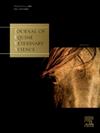Tight nosebands apply high pressures on the horses’ face and alter stride kinematics
IF 1.6
3区 农林科学
Q2 VETERINARY SCIENCES
引用次数: 0
Abstract
Background
Noseband tightness has received increasing attention within equitation science, however, there is little research into how this effects equine behaviour or performance.
Aims/objectives
1) determine the peak pressures under noseband in vivo at three different tightness; 2) assess limb and back kinematics at different noseband tightness.
Methods
Noseband tightness (n = 8 horses) was set using an International Society for Equine Science (ISES) taper gauge with the three settings being; “two fingers (2F)”, “one finger (1F)” and “zero fingers (0F)”. Peak pressure under noseband was determined using pressure sensors under. Motion capture was used to analyse kinematics of limb and back.
Results
Peak pressures at 1F (40.9 ± 7.2 kPa) and 0F (115.8 ± 52.6 kPa), when compared to 2F (26.4 ± 7.2 kPa), showed a 54% and 338% increase, respectively (F (1.027, 7.192) = 21.012, P = 0.002). As the noseband tightness increased, stride length decreased, showing a statistically significant negative correlation (rs(22) = -0.592, P = 0.004). A mean decrease in stride length of 6.2% was seen with the 1F when compared to 2F and an 11.1% decrease was seen at 0F when compared to 2F.
Conclusion
In conclusion, as the noseband was tightened, peak pressure increased and this has a detrimental effect on horses’ kinematics, markedly stride kinematics.
紧鼻带对马的面部施加高压,并改变其步幅运动学。
背景:鼻带紧度在马术科学中受到越来越多的关注,然而,关于这如何影响马的行为或表现的研究很少。目的/目标:1)确定三种不同松紧度下鼻带在体内的峰值压力;2)评估不同鼻带松紧度下的肢体和背部运动学。方法:鼻带紧度(n=8匹马)采用国际马科学学会(ISES)锥度规进行设置,三种设置分别为;“两指(2F)”、“一指(1F)”和“零指(0F)”。采用压力传感器测定鼻带下的峰值压力。采用运动捕捉技术对四肢和背部进行运动学分析。结果:与2F(26.4±7.2kPa)相比,1F(40.9±7.2kPa)和0F(115.8±52.6kPa)时的峰值压力分别升高了54%和338% (F(1.027, 7.192) = 21.012,P=0.002)。随着鼻带松紧度的增加,步长减小,呈显著负相关(rs(22) = -0.592,P = 0.004)。与2F相比,0F的步幅平均减少了6.2%,0F的步幅平均减少了11.1%。结论:综上所述,随着鼻带收紧,峰值压力增加,这对马的运动学,特别是跨步运动学有不利影响。
本文章由计算机程序翻译,如有差异,请以英文原文为准。
求助全文
约1分钟内获得全文
求助全文
来源期刊

Journal of Equine Veterinary Science
农林科学-兽医学
CiteScore
2.70
自引率
7.70%
发文量
249
审稿时长
77 days
期刊介绍:
Journal of Equine Veterinary Science (JEVS) is an international publication designed for the practicing equine veterinarian, equine researcher, and other equine health care specialist. Published monthly, each issue of JEVS includes original research, reviews, case reports, short communications, and clinical techniques from leaders in the equine veterinary field, covering such topics as laminitis, reproduction, infectious disease, parasitology, behavior, podology, internal medicine, surgery and nutrition.
 求助内容:
求助内容: 应助结果提醒方式:
应助结果提醒方式:


